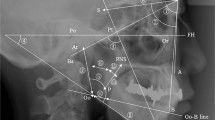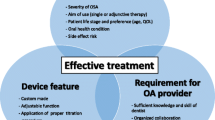Abstract
Purpose
Oral appliance therapy is an alternative treatment modality for obstructive sleep apnea (OSA). However, there have been no studies to determine whether changes in the obstructive pattern occur following long-term use of oral devices. Therefore, we examined whether the obstructive pattern changes in patients with OSA who undergo long-term oral appliance therapy using drug-induced sleep endoscopy (DISE).
Methods
We investigated 156 consecutive patients diagnosed with OSA. Seventy-nine of these patients were found to be eligible for inclusion in this study. All enrolled patients underwent two DISE examinations: before and after oral appliance use. We compared the DISE findings for each patient in terms of degree and configuration of airway obstruction at the levels of the velum, oropharynx, tongue base, and epiglottis.
Results
We found that dental problems, as assessed using the average values of overjet and overbite, were significantly decreased after 2 years of oral appliance use. Comparisons of the DISE findings revealed that there was significant widening of the upper airway structures following long-term oral appliance therapy, especially in the velum (P = 0.022) and epiglottis (P = 0.001). However, changes in the configuration of upper airway obstruction were not observed in any of the structures of the upper airway.
Conclusions
We found evidence possibly indicating decreased obstruction at the levels of the velum and epiglottis after long-term use of oral appliances. We suggest further cohort studies to confirm these findings.


Similar content being viewed by others
References
Guilleminault C, Tilkian A, Dement WC (1976) The sleep apnea syndromes. Ann Re Med 27:465–484
Redline S, Strohl KP (1998) Recognition and consequences of obstructive sleep apnea hypopnea syndrome. Clin Chest Med 19(1):1–19
Marin JM, Carrizo SJ, Vicente E, Agusti AG (2005) Long-term cardiovascular outcomes in men with obstructive sleep apnoea-hypopnoea with or without treatment with continuous positive airway pressure: an observational study. Lancet 365(9464):1046–1053
Yaggi HK, Concato J, Kernan WN, Lichtman JH, Brass LM, Mohsenin V (2005) Obstructive sleep apnea as a risk factor for stroke and death. N Eng J Med 353(19):2034–2041
George CF (2001) Reduction in motor vehicle collisions following treatment of sleep apnoea with nasal CPAP. Thorax 56(7):508–512
Giles TL, Lasserson TJ, Smith BH, White J, Wright J, Cates CJ (2006) Continuous positive airways pressure for obstructive sleep apnoea in adults. Cochrane Database Syst Rev (3):CD001106
Sawyer AM, Gooneratne NS, Marcus CL, Ofer D, Richards KC, Weaver TE (2011) A systematic review of CPAP adherence across age groups: clinical and empiric insights for developing CPAP adherence interventions. Sleep Med Rev 15(6):343–356
Lim J, Lasserson TJ, Fleetham J, Wright J (2006) Oral appliances for obstructive sleep apnoea. Cochrane Database Syst Rev (1):CD004435
Marklund M (2006) Predictors of long-term orthodontic side effects from mandibular advancement devices in patients with snoring and obstructive sleep apnea. Am J Orthod Dentofac Orthop 129(2):214–221
Sutherland K, Vanderveken OM, Tsuda H, Marklund M, Gagnadoux F, Kushida CA, Cistulli PA (2014) Oral appliance treatment for obstructive sleep apnea: an update. J Clin Sleep Med 10(2):215–227
Ahrens A, McGrath C, Hagg U (2011) A systematic review of the efficacy of oral appliance design in the management of obstructive sleep apnoea. Eur J Orthod 33(3):318–324
Rose E, Staats R, Virchow C, Jonas IE (2002) A comparative study of two mandibular advancement appliances for the treatment of obstructive sleep apnoea. Eur J Orthod 24(2):191–198
Aarab G, Lobbezoo F, Heymans MW, Hamburger HL, Naeije M (2011) Long-term follow-up of a randomized controlled trial of oral appliance therapy in obstructive sleep apnea. Respiration 82(2):162–168
Doff MH, Hoekema A, Pruim GJ, Huddleston Slater JJ, Stegenga B (2010) Long-term oral-appliance therapy in obstructive sleep apnea: a cephalometric study of craniofacial changes. J Dent 38(12):1010–1018
Giannasi LC, Almeida FR, Magini M, Costa MS, de Oliveira CS, de Oliveira JC, Kalil Bussadori S, de Oliveira LV (2009) Systematic assessment of the impact of oral appliance therapy on the temporomandibular joint during treatment of obstructive sleep apnea: long-term evaluation. Sleep Breath 13(4):375–381
Almeida FR, Lowe AA, Otsuka R, Fastlicht S, Farbood M, Tsuiki S (2006) Long-term sequellae of oral appliance therapy in obstructive sleep apnea patients: Part 2. Study-model analysis. Am J Orthod Dentofac Orthop 129(2):205–213
Ravesloot MJ, de Vries N (2011) One hundred consecutive patients undergoing drug-induced sleep endoscopy: results and evaluation. Laryngoscope 121(12):2710–2716
Cho JS, Soh S, Kim EJ, Cho HJ, Shin S, Kim HJ, Koo BN (2015) Comparison of three sedation regimens for drug-induced sleep endoscopy. Sleep Breath 19(2):711–717
Heiser C, Fthenakis P, Hapfelmeier A, Berger S, Hofauer B, Hohenhorst W, Kochs EF, Wagner KJ, Edenharter GM (2017) Drug-induced sleep endoscopy with target-controlled infusion using propofol and monitored depth of sedation to determine treatment strategies in obstructive sleep apnea. Sleep Breath 21(3):737–744
Park SM, Kim DK (2017) Effect of physical stress on drug-induced sleep endoscopy for obstructive sleep apnea. Eur Arch Oto-Rhino-Laryngol 274(8):3115–3120
Carrasco-Llatas M, Zerpa-Zerpa V, Dalmau-Galofre J (2017) Reliability of drug-induced sedation endoscopy: interobserver agreement. Sleep Breath 21(1):173–179
Vroegop AV, Vanderveken OM, Dieltjens M, Wouters K, Saldien V, Braem MJ, Van de Heyning PH (2013) Sleep endoscopy with simulation bite for prediction of oral appliance treatment outcome. J Sleep Res 22(3):348–355
De Corso E, Bastanza G, Della Marca G, Grippaudo C, Rizzotto G, Marchese MR, Fiorita A, Sergi B, Meucci D, Di Nardo W, Paludetti G, Scarano E (2015) Drug-induced sleep endoscopy as a selection tool for mandibular advancement therapy by oral device in patients with mild to moderate obstructive sleep apnoea. Acta Otorhinolaryngol Italica 35 (6):426–432
Battagel JM, Johal A, Kotecha BT (2005) Sleep nasendoscopy as a predictor of treatment success in snorers using mandibular advancement splints. J Laryngol Otol 119(2):106–112
Fulstow ED (1968) The early treatment of Angle’s Class II, Division 1 malocclusion. Dent Pract Dent Rec 19(4):137–144
Kezirian EJ, Hohenhorst W, de Vries N (2011) Drug-induced sleep endoscopy: the VOTE classification. Eur Arch Oto-Rhino-Laryngol 268(8):1233–1236
Rodriguez-Bruno K, Goldberg AN, McCulloch CE, Kezirian EJ (2009) Test-retest reliability of drug-induced sleep endoscopy. Otolaryngol Head Neck Surg 140(5):646–651
Kezirian EJ, White DP, Malhotra A, Ma W, McCulloch CE, Goldberg AN (2010) Interrater reliability of drug-induced sleep endoscopy. Arch Otolaryngol Head Neck Surg 136(4):393–397
Almeida FR, Bansback N (2013) Long-term effectiveness of oral appliance versus CPAP therapy and the emerging importance of understanding patient preferences. Sleep 36(9):1271–1272
de Almeida FR, Lowe AA, Tsuiki S, Otsuka R, Wong M, Fastlicht S, Ryan F (2005) Long-term compliance and side effects of oral appliances used for the treatment of snoring and obstructive sleep apnea syndrome. J Clin Sleep Med 1(2):143–152
Gong X, Zhang J, Zhao Y, Gao X (2013) Long-term therapeutic efficacy of oral appliances in treatment of obstructive sleep apnea-hypopnea syndrome. Angle Orthod 83(4):653–658
Doff MH, Finnema KJ, Hoekema A, Wijkstra PJ, de Bont LG, Stegenga B (2013) Long-term oral appliance therapy in obstructive sleep apnea syndrome: a controlled study on dental side effects. Clini Oral Investig 17(2):475–482
Bae SH, Kim MJ, Lee SM, Lee HJ, Park HS, Lee JH, Park CH, Kim DK (2017) Analysis of long-term complication on patients with obstructive sleep apnea who treated mandibular advancement device. Korean J Otorhinolaryngol-Head Neck Surg 60(9):449–453
Ringqvist M, Walker-Engstrom ML, Tegelberg A, Ringqvist I (2003) Dental and skeletal changes after 4 years of obstructive sleep apnea treatment with a mandibular advancement device: a prospective, randomized study. Am J Orthod Dentofac Orthop 124(1):53–60
Mehta A, Qian J, Petocz P, Darendeliler MA, Cistulli PA (2001) A randomized, controlled study of a mandibular advancement splint for obstructive sleep apnea. American J Respir Crit Care Med 163(6):1457–1461
Chen H, Lowe AA, de Almeida FR, Fleetham JA, Wang B (2008) Three-dimensional computer-assisted study model analysis of long-term oral-appliance wear. Part 2. Side effects of oral appliances in obstructive sleep apnea patients. Am J Orthod Dentofac Orthop 134(3):408–417
de Almeida FR, Bittencourt LR, de Almeida CI, Tsuiki S, Lowe AA, Tufik S (2002) Effects of mandibular posture on obstructive sleep apnea severity and the temporomandibular joint in patients fitted with an oral appliance. Sleep 25(5):507–513
Fransson AM, Tegelberg A, Johansson A, Wenneberg B (2004) Influence on the masticatory system in treatment of obstructive sleep apnea and snoring with a mandibular protruding device: a 2-year follow-up. Am J Orthod Dentofac Orthop 126(6):687–693
Martinez-Gomis J, Willaert E, Nogues L, Pascual M, Somoza M, Monasterio C (2010) Five years of sleep apnea treatment with a mandibular advancement device. Side effects and technical complications. Angle Orthod 80(1):30–36
Cunali PA, Almeida FR, Santos CD, Valdrighi NY, Nascimento LS, Dal’Fabbro C, Tufik S, Bittencourt LR (2009) Prevalence of temporomandibular disorders in obstructive sleep apnea patients referred for oral appliance therapy. J Orofac Pain 23(4):339–344
Mayer G, Meier-Ewert K (1995) Cephalometric predictors for orthopaedic mandibular advancement in obstructive sleep apnoea. Eur J Orthod 17(1):35–43
Tsuiki S, Hiyama S, Ono T, Imamura N, Ishiwata Y, Kuroda T, Lowe AA (2001) Effects of a titratable oral appliance on supine airway size in awake non-apneic individuals. Sleep 24(5):554–560
Gao XM, Zeng XL, Fu MK, Huang XZ (1999) Magnetic resonance imaging of the upper airway in obstructive sleep apnea before and after oral appliance therapy. Chin J Dent Res 2(2):27–35
Ishida M, Inoue Y, Suto Y, Okamoto K, Ryoke K, Higami S, Suzuki T, Kawahara R (1998) Mechanism of action and therapeutic indication of prosthetic mandibular advancement in obstructive sleep apnea syndrome. Psychiatry Clin Neurosc 52(2):227–229
Acknowledgements
This research was supported by the Hallym University Research Fund (to Jo Seo Yun and Dong-Kyu Kim) and by the Hallym University Research Fund 2016 (HURF-2015-43, to Dong-Kyu Kim).
Funding
This research was supported by the Hallym University Research Fund (to Jo Seo Yun and Dong-Kyu Kim) and by the Hallym University Research Fund 2016 (HURF-2015-43, to Dong-Kyu Kim).
Author information
Authors and Affiliations
Corresponding author
Ethics declarations
Conflict of interest
The authors have indicated no financial conflicts of interest.
Ethical approval
The study protocol was approved by our Institutional Review Board, and all subjects provided written informed consent.
Rights and permissions
About this article
Cite this article
Jo, S.Y., Lee, S.M., Lee, K.H. et al. Effect of long-term oral appliance therapy on obstruction pattern in patients with obstructive sleep apnea. Eur Arch Otorhinolaryngol 275, 1327–1333 (2018). https://doi.org/10.1007/s00405-018-4909-4
Received:
Accepted:
Published:
Issue Date:
DOI: https://doi.org/10.1007/s00405-018-4909-4




